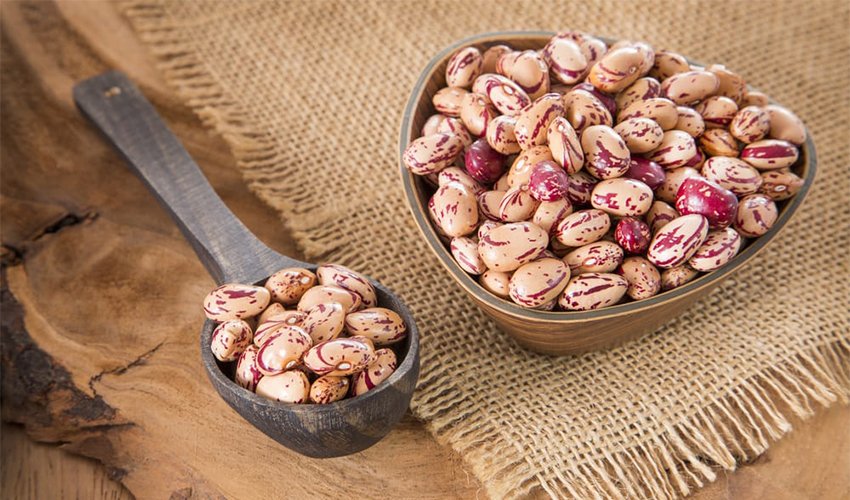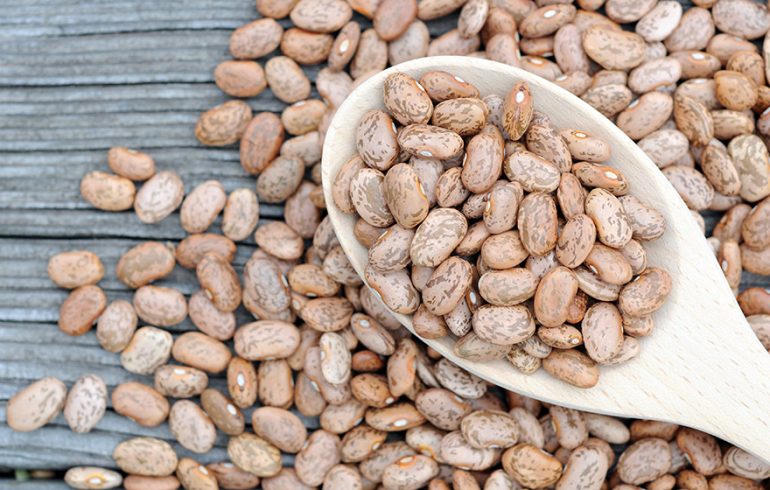Pinto beans are budget-friendly, nutritious, versatile legumes commonly used in soups, stews, and rice dishes. They are very popular in Mexican cuisine. Since they are a good source of plant protein, fiber, and antioxidants, pinto beans make an easy and smart addition to your diet. Health Benefits and Nutrition Facts of Pinto beans you should know.
Contents
Health Benefits and Nutrition Facts of Pinto beans
Pinto Bean Nutrition Facts
Fats
There is only 1 gram of fat in pinto beans, which makes them a naturally low-fat food. While some nutrition experts caution against the use of processed, low-fat foods for weight loss or healthy weight maintenance, foods like pinto beans that naturally provide good nutrition and little to no fat are a smart addition to any diet.
Protein
Each serving of pinto beans provides a substantial 15 grams of protein. For this reason, many vegans and vegetarians use pinto beans or other types of legumes to boost their protein intake. However, pinto beans are not considered a complete protein. Complete proteins provide all of the essential amino acids that cannot be made by the body and therefore must be consumed in the diet. You’ll also need to consume whole grains, nuts, or seeds in order to get all essential amino acids during the course of a day on a plant-based diet.
Vitamins and Minerals
Pinto beans are packed with nutrients. You’ll get 74% of your daily recommended intake of folate (294mcg) if you consume one cup of pinto beans and you follow a 2,000-calorie per day diet. Folate, a B vitamin, helps boost red blood cell production and provides other health benefits.
Pinto Bean Health Benefits
Supports Glycemic Control
A different review study found that increasing intake of beans, peas, lentils can help both people with and without diabetes improve long-term glycemic control in their diets.8 Related: A 2013 study published evidence that flavonol, one of the antioxidants found in beans, could lower the incidence of type 2 diabetes.9 Another study, published in 2014, notes that the fiber content in beans also helps maintain healthy blood sugar levels.
Increases Longevity With Fiber
A large review study (encompassing 1.75 million subjects) concluded that high dietary fiber intake is associated with lower mortality rates and specifically, mortality due to heart disease, cancer, digestive disease, infectious diseases, and other inflammatory diseases.
Diabetes-friendly
Beans have a low glycemic index rating, which means that the body absorbs energy from them slowly. This helps prevent your blood sugar from spiking after a meal. People with diabetes, especially Type 2 diabetes, often find that low-glycemic-index foods like beans help them manage their blood sugar and insulin levels more effectively.
Lowers “bad” cholesterol
Beans are rich in soluble fiber, which is a kind of fiber that turns into a watery gel in your stomach. This gel absorbs cholesterol, especially “bad” LDL cholesterol before your body can. Lower cholesterol levels help prevent problems like heart disease and stroke.
Maintain Your Memory with Thiamin (Vitamin B1)
The B vitamin, thiamin participates in enzymatic reactions central to energy production and is also critical for brain cell/cognitive function. This is because thiamin is needed for the synthesis of acetylcholine, the important neurotransmitter essential for memory and whose lack has been found to be a significant contributing factor in age-related impairment in mental function (senility) and Alzheimer’s disease. Alzheimer’s disease is clinically characterized by a decrease in acetylcholine levels.
Protein Power Plus
If you’re wondering how to replace red meat in your menus, become a fan of pinto beans. These hearty beans are a good source of protein, and when combined with a whole grain such as whole-wheat pasta or brown rice, provide protein comparable to that of meat or dairy foods without the high calories or saturated fat found in these foods. And, when you get your protein from pinto beans, you also get the blood sugar-stabilizing and heart health benefits of the soluble fiber provided by these versatile legumes. A cup of pinto beans provides over 15 grams of protein.
How to Enjoy
A Few Quick Serving Ideas
- Use pinto beans in chili recipes in place of kidney beans.
- Blend together pinto beans with sage, oregano, garlic, and black pepper for a delicious spread that can be used as a crudité dip or sandwich filling.
- Layer cooked pinto beans, chopped tomatoes and onions, and shredded cheese on a tortilla. Broil in the oven until hot and cheese melts. Top with chopped avocado and cilantro.
- Add pinto beans to vegetable soups.
- Heat pinto beans together with cooked rice. Add cooked chopped vegetables such as carrots, zucchini, and tomatoes. Season to taste and enjoy this simple-to-prepare one-pot meal.









